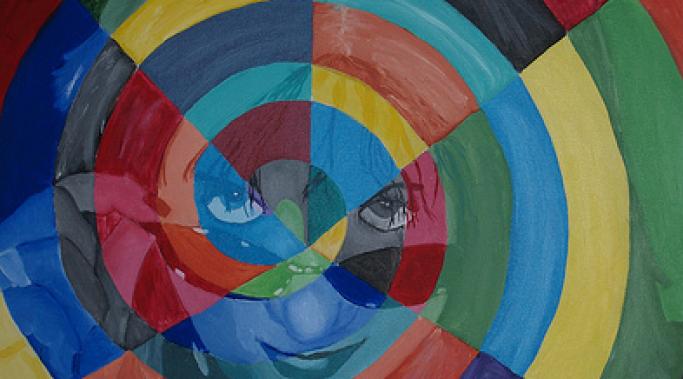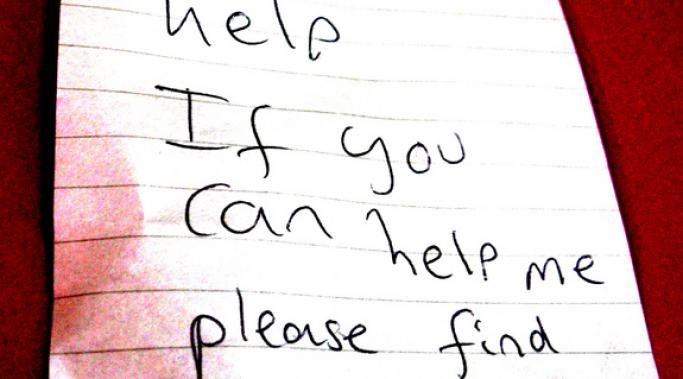Yesterday, I came across a picture of a sign I’d taken several months ago while out shopping. The sign was under a display of eye shadow applicators that each contained two different colors and it read, “Split Personality – brings out the best in both of you.” Two shades of make-up, one for each personality. I’m sure someone fancied themselves terribly clever when they came up with that. But as much as I loathe the idea of suiting up with the PC police, I have to say that glamorizing Dissociative Identity Disorder to sell beauty products isn’t at all clever. In fact, I think that the pervasive use of mental illnesses as punch lines undermines efforts to promote understanding and support for people living with them.
Dissociative Living
I’ve discussed my difficulties with setting personal boundaries and some of what contributes to those difficulties. But it occurs to me that there may be a link between the high suggestibility of people with Dissociative Identity Disorder and the challenges so many of us face with personal boundaries. It seems reasonable that saying no would be more difficult for people who are particularly susceptible to the power of suggestion.
Like so many others with dissociative identity disorder (DID), I have comorbid posttraumatic stress disorder. But it isn’t the temporary response to short-lived trauma that most people think of as PTSD. It’s a deeper, more pervasive, and chronic response to life in general. This form of PTSD is called complex PTSD. And it occurs so often in conjunction with dissociative identity disorder, that I sometimes wonder if there's anyone with DID who doesn’t live with this monster.
When it comes to understanding Dissociative Identity Disorder, most people get too hung up on the concept of the alternate identity. Identity alteration is widely and mistakenly accepted as the essence of what DID is. And so the two most popular theories about the development of Dissociative Identity Disorder revolve around the existence of alters: the Broken Vase Theory, and the Multiple Vase Theory. Neither are satisfactory explanations for how DID develops and ultimately both theories' inaccuracies stem from the same error: the assumption that early childhood identity is cohesive and intact when in fact it is anything but.
One of the two most popular theories about the development of Dissociative Identity Disorder states that if you take a child with an intact identity and apply severe force for long enough, the child’s identity will splinter into pieces. I call it the Broken Vase Theory. I also call it wrong.
Despite reminder tools and sheer determination, I keep forgetting to take my medication. I get up in the morning and think to myself, 'Now don’t forget to take your medication!' while heading to the bathroom where it’s waiting for me in a brightly colored container right there on the counter. And I repeatedly discover, much later in the day, those pills lying untouched in their little compartments. I have dissociative identity disorder and this is just one example of how my dissociative memory affects my everyday life. On its own it may not seem like a big deal. And if my memory problems were exclusive to forgetting medication or if they were irregular, here-and-there occurrences they probably wouldn’t be much of an issue. But what I just described is how my memory works all the time, with everything.
Recently I heard a familiar story from someone struggling to understand her dissociative disorder but unable to get any direct answers or explanations from her therapist, who is exercising caution because she doesn't want to reinforce the dissociation. While this is an understandable and common concern for clinicians treating Dissociative Identity Disorder, there is a vast difference between psychoeducation and fostering further fragmentation. When you refuse to fully invest in the former you leave your clients ripe for the latter. If for no other reason than that, Dissociative Identity Disorder treatment must include psychoeducation.
Dissociative Identity Disorder is caused not just by trauma, but a number of factors that come together at just the right times, in just the right places, over and over again. I’ve discussed in some depth the factors that I believe contributed to my development of DID. But those factors might be different for you. Furthermore, each contributing factor carries its own weight. In other words, the causes of Dissociative Identity Disorder are unique to each person in both definition and size.
Decreasing dissociation in dissociative identity disorder (DID) relies on actively increasing awareness of the world around us. Dissociation is the process by which we separate ourselves from our experiences, memories, bodies, and very selves. When we're dissociating, we're disengaged from some or all of our own reality.
It's not inherently a bad thing; I truly believe dissociation serves a valuable purpose, and not just in traumatic circumstances. But there's no doubt that the chronic, severe dissociation intrinsic to dissociative identity disorder is problematic, disruptive, even at times actively destructive. By increasing awareness, by being more fully present in our bodies and minds, we can mitigate the damaging effects of dissociation.
While not everyone with Dissociative Identity Disorder also has a diagnosable depressive disorder, I’d wager at least 50% live regularly with some type of depression. As for me, I have Major Depression and Dysthymia. The former is a real pain; the latter is far more manageable. I’ve never taken either one very seriously and I think the magnetic relationship between dissociation and depression is the primary reason why.









